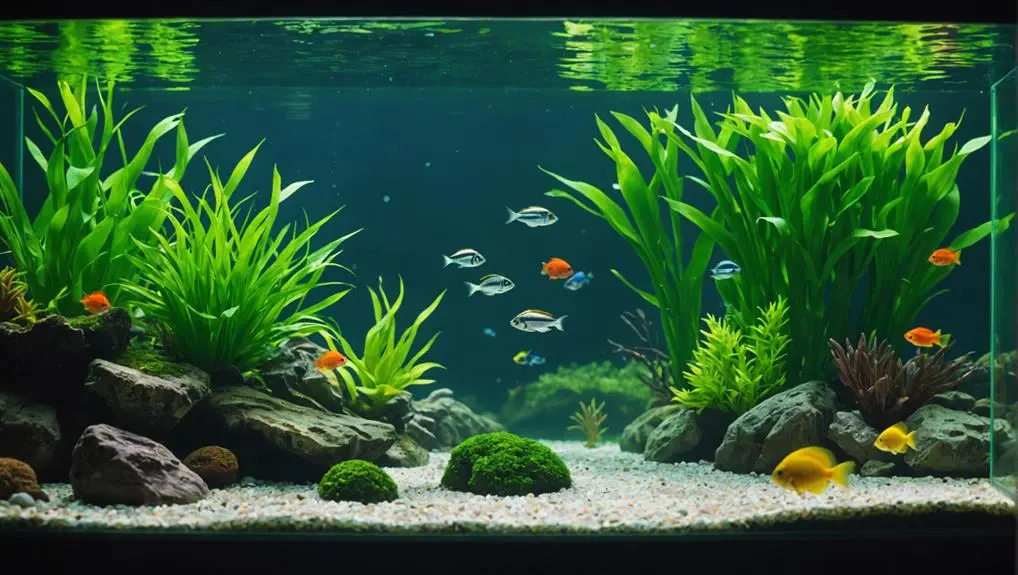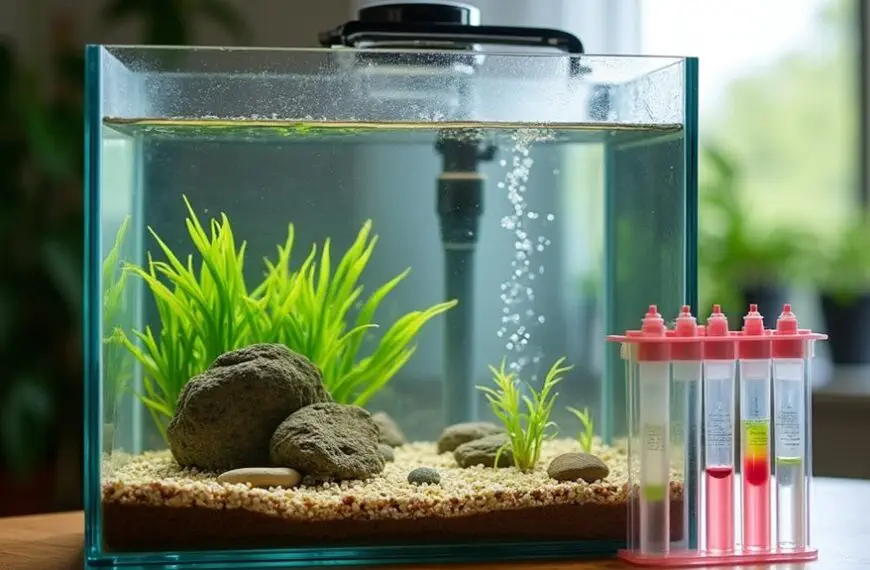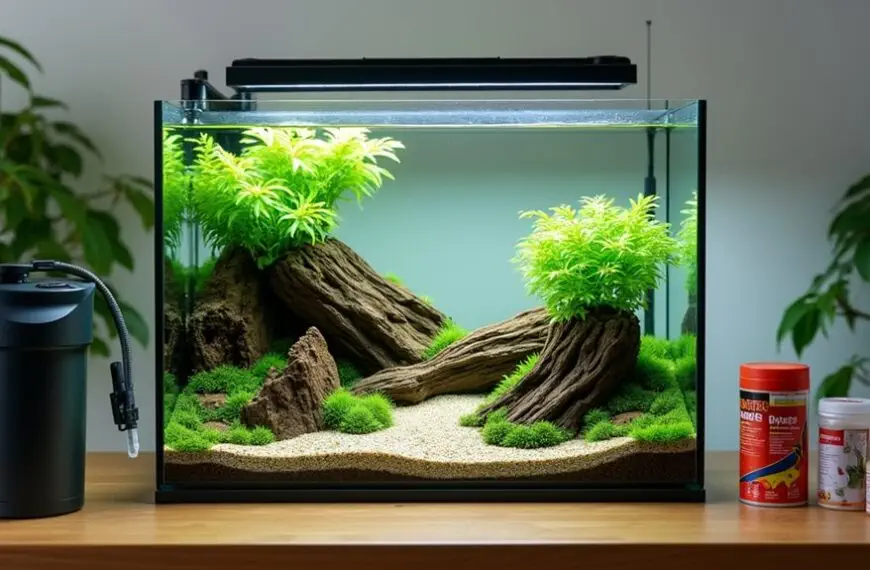To keep your fish tank water quality top-notch, start with regular water changes. Aim for 10-15% once a week to refresh the water and rid it of waste. Keep an eye on key parameters like pH, ammonia, and nitrate levels, using a testing kit. If things look cloudy or your fish are acting weird, that's a sign you need to check what's going on. Don't forget to clean the substrate and change the filter media monthly. With a little bit of routine care, your fish will thank you—and if you're curious about more tips to help them thrive, stick around!
Contents
Importance of Water Quality
When you maintain high water quality in your fish tank, you're directly supporting the health and well-being of your aquatic pets. Good water quality is crucial because it keeps your fish happy and stress-free. If ammonia and nitrite levels rise, your fish can become sick or even die. That's why you need to monitor those levels regularly with test kits.
A biological filter does wonders by breaking down fish waste and keeping the water clean. But remember, even the best filter can't do it all. Regular water changes are essential to remove toxins and maintain a stable pH, which is vital for your fish's survival.
The presence of nitrifying bacteria helps break down harmful substances, but they need your help to thrive.
Consider this: a stable aquarium environment not only supports fish growth and breeding but also promotes longevity. Larger tanks can offer more stability, so if you're thinking of upgrading, it might be a good idea.
With a little effort and attention, you can create a thriving underwater paradise—your fish will thank you for it! And who doesn't love a happy, colorful tank?
Key Water Parameters
Maintaining key water parameters is essential for creating a healthy environment for your fish. You want to keep those nitrate levels below 20 ppm since anything above 40 ppm can be harmful. Your fish would really appreciate it!
Nitrite levels should always be at 0 ppm, as even tiny amounts can stress them out.
Next up, total hardness, or GH, should sit between 50-150 ppm to keep community fish happy. The pH level is just as crucial; aim for a range of 6.5 to 7.5 and avoid sudden fluctuations, which can be quite stressful for your aquatic pals.
Don't forget about total chlorine! You'll want that to test at 0 ppm, too, because even small traces can affect fish gills and overall health.
Lastly, be mindful of waste products and organic debris in your tank; they can throw off your water chemistry. Regular partial water changes are your best friend in maintaining these parameters.
Regular Maintenance Practices
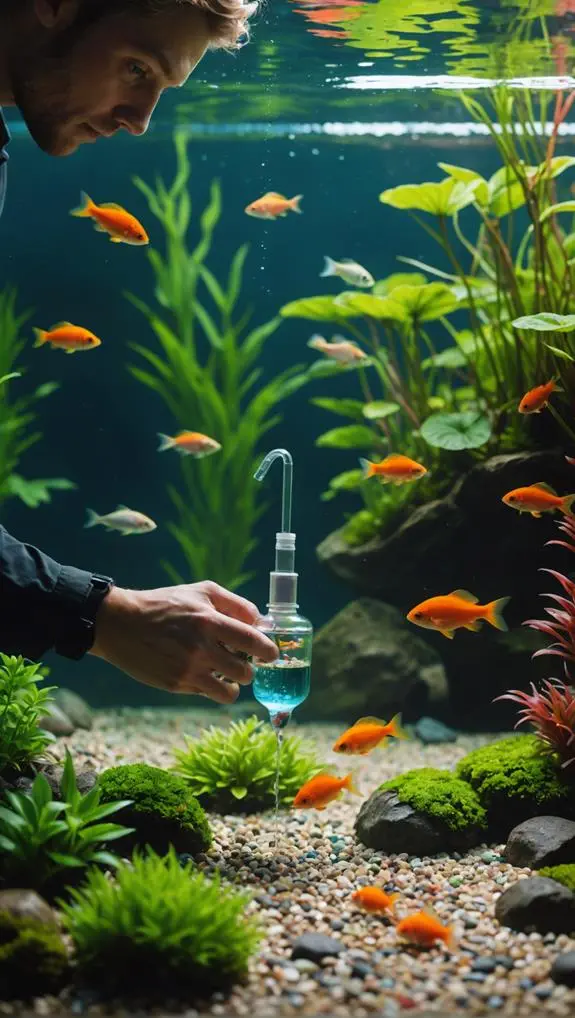
Regular maintenance practices are crucial for keeping your fish tank healthy and thriving. By regularly tending to your aquarium, you not only ensure a better environment for your fish but also show them just how much you care.
Here are some essential steps to follow:
- Conduct partial water changes of 10-15% weekly to refresh the tank and lower harmful nitrate and nitrite levels.
- Clean the substrate to remove uneaten food and waste, preventing toxic buildup that could harm your fish.
- Change chemical filter media monthly to effectively remove pollutants and keep microbial growth at bay.
- Replace or rinse mechanical filter media weekly, so decomposing debris doesn't reintroduce harmful nutrients back into your water.
Don't forget to test water parameters weekly, including ammonia, nitrite, nitrate, and pH levels.
This proactive approach helps you catch any toxic spikes early. By embracing these regular maintenance practices, you're actively supporting your fish's health and enriching their underwater world.
Plus, watching your fish thrive can be incredibly rewarding—like having tiny, colorful pets that truly appreciate your efforts!
Recognizing Signs of Poor Quality
Recognizing signs of poor water quality in your fish tank is essential for keeping your aquatic pets healthy and happy.
Pay close attention to any unusual behaviors, like your fish gasping at the surface or acting lethargic. These could be red flags indicating poor water quality or elevated ammonia levels.
If you notice cloudy water, it might be a sign of bacterial blooms triggered by excess organic waste. This can lead to oxygen depletion and serious fish stress.
Keep an eye out for signs of distress, such as clamped fins or hiding more than usual. These behaviors can often be linked to fluctuating pH levels or high nitrite concentrations.
And let's not forget about smell—if your tank has an unpleasant odor, it could indicate decaying organic matter or high ammonia levels, both of which are harmful to your fish.
Essential Equipment for Maintenance
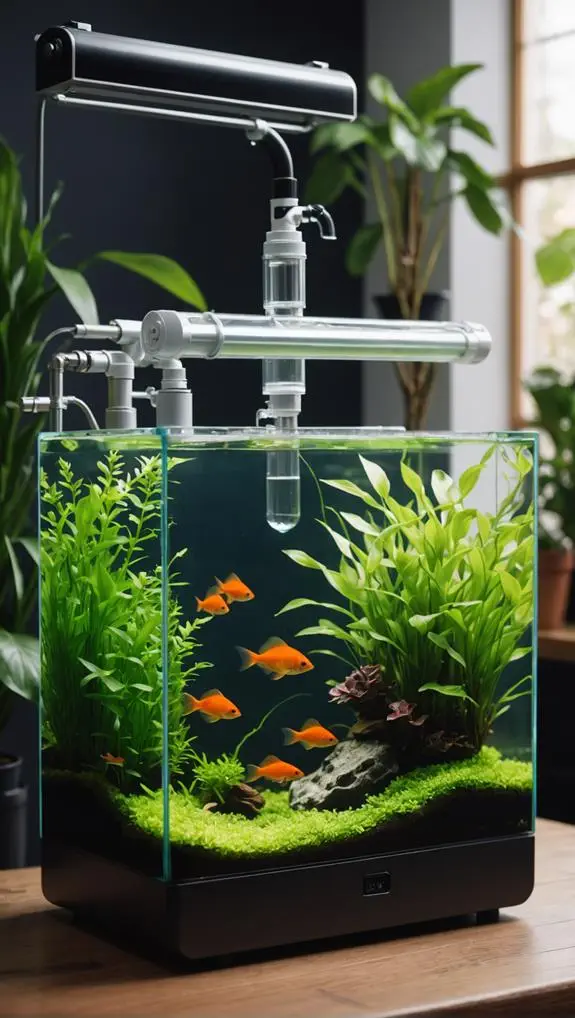
How can you ensure the health of your fish and the overall quality of your aquarium? Having the right equipment is key to maintaining a vibrant aquatic ecosystem.
Here are four essentials every aquarium owner should consider:
- Water Testing Kits: These are your first line of defense against heavy metals and toxins. Regular testing helps you catch issues before they turn into major problems.
- Filtration Systems: A good filter not only cleans the water but also provides a home for beneficial bacteria, which help break down waste and keep your fish happy.
- Submersible Heaters: Tropical fish love their warm baths! Adjustable heaters keep the water between 72-80°F, ensuring your fish are comfortable and healthy.
- UV Sterilizers: These nifty devices reduce harmful microorganisms, boosting water quality and keeping your fish thriving.
Lastly, don't forget air pumps! They increase oxygen levels, which are vital for your fish's respiration, especially in densely stocked tanks.
With this equipment, you can create a safe and healthy environment for your aquatic friends, and they'll surely appreciate the effort!
Frequently Asked Questions
How to Keep Good Water Quality in a Fish Tank?
To keep good water quality in your fish tank, regularly test water parameters, maintain filtration systems, control algae, adjust water temperature, and perform water changes. Also, focus on substrate maintenance and plant health for thriving fish species.
How Do I Keep My Fish Tank Fresh Water Healthy?
To keep your freshwater aquarium thriving, master filtration systems and aquarium cycling. Regular water changes maintain chemical balance, while monitoring pH levels and temperature control ensures fish compatibility. Don't forget about plant health and algae management for a vibrant ecosystem!
How Can I Keep My Fish Tank Water Clean?
To keep your tank water clean, focus on effective tank filtration and regular water changes. Monitor chemical testing, maintain substrate cleanliness, control algae, ensure proper fish feeding, and sanitize equipment while using water conditioners for optimal health.
How Do I Get the Perfect Water for My Fish Tank?
"Good things come to those who wait." To get perfect water, monitor pH levels, water hardness, and temperature. Use filtration systems, perform regular water changes, and add conditioning agents, beneficial bacteria, and algae control with test kits.
Final Thoughts
Keeping your fish tank water in tip-top shape is like tending to a delicate garden. With a little effort, you can create a sparkling underwater paradise for your finned friends. Regular checks and maintenance ensure they swim happily, free from stress and illness. Remember, a clean tank not only looks good but keeps your aquatic buddies thriving. So dive in, roll up your sleeves, and enjoy the rewarding journey of maintaining a beautiful, healthy home for your fish!

